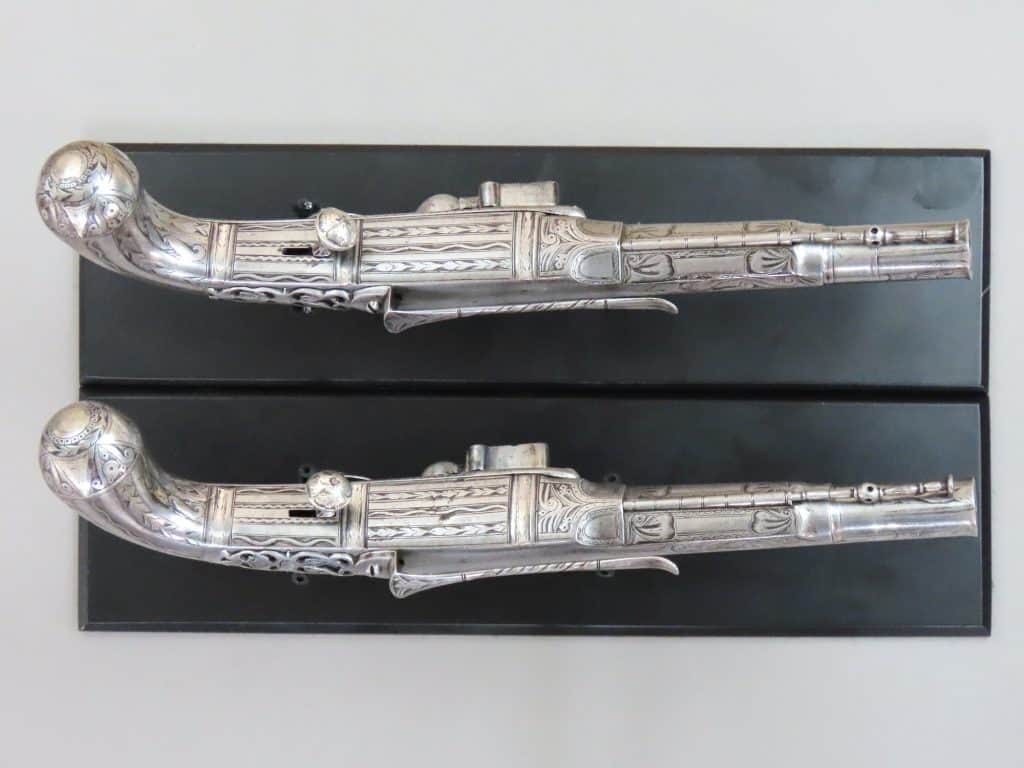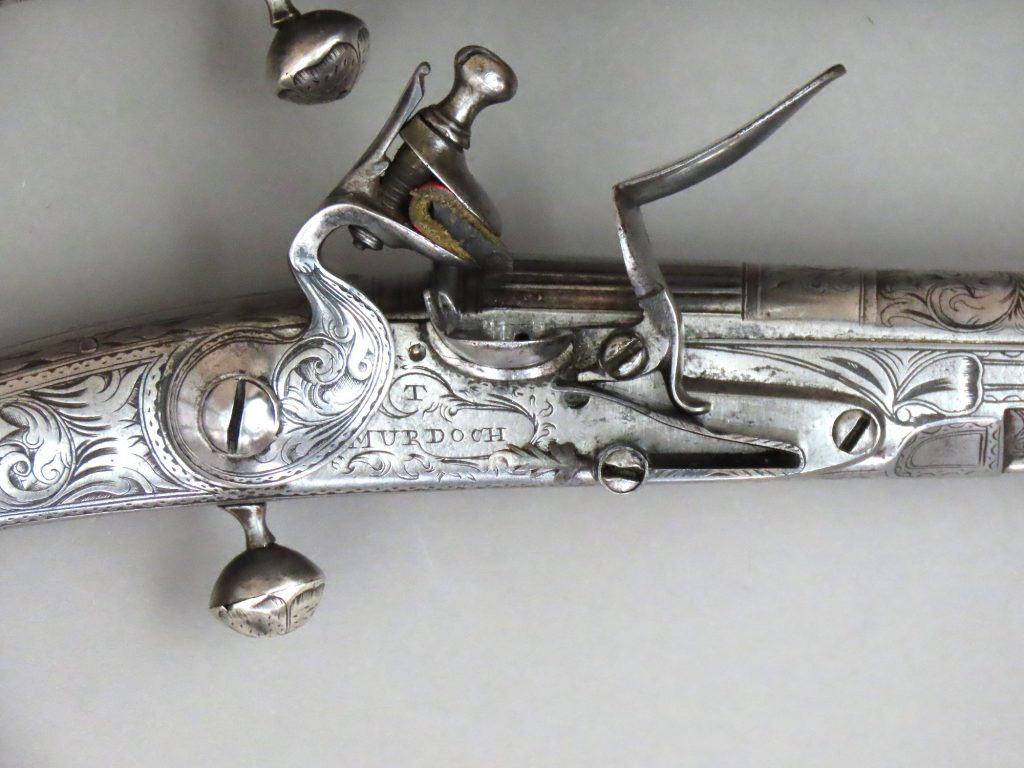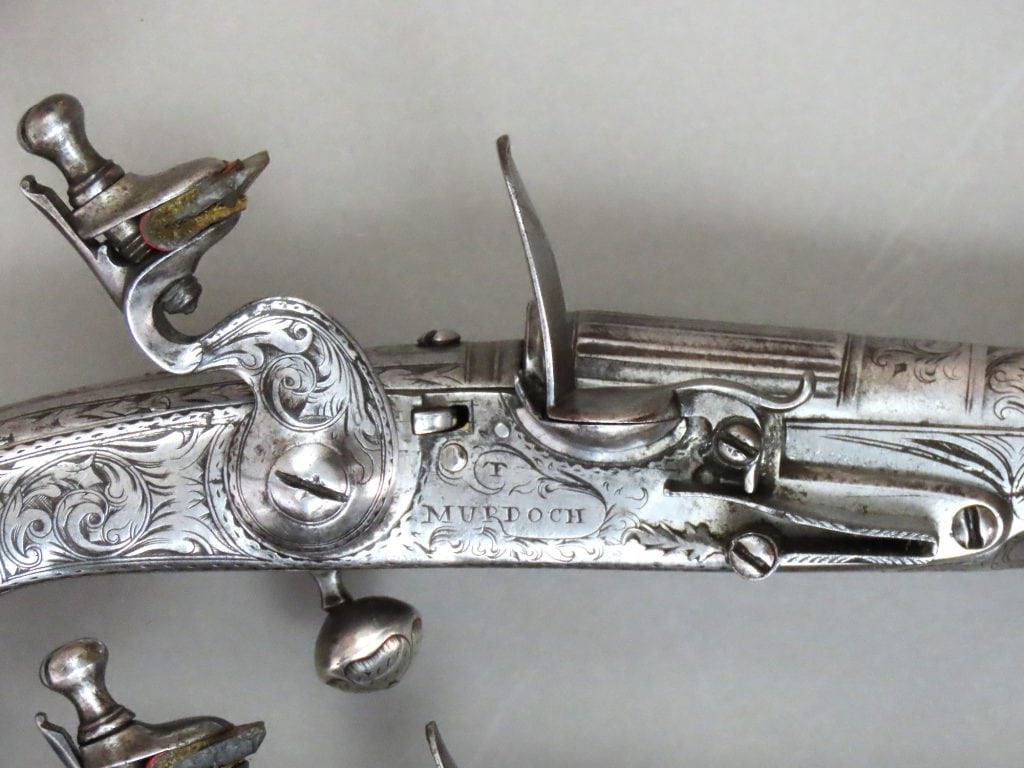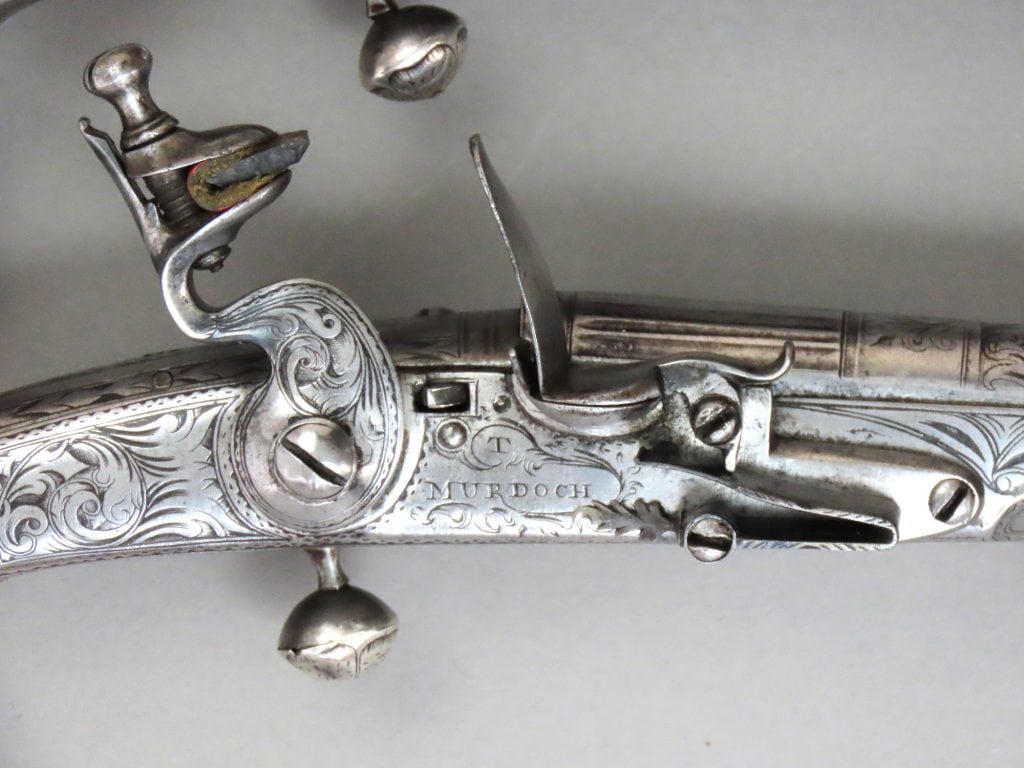A Pair of Scottish Lobe Butt Pistols by Thomas Murdoch of Doune dating to the Mid 18th Century
A fine and rare pair of 28 bore all steel Scottish Lobe Butt pistols by Thomas Murdoch of Doune, dating to the middle period of the 18th century, presented in fine and original condition. These pistols are typical examples of the high standards represented by the Doune gun makers. Pistols of this type and date were popular with officers in Scottish Highland regiments on service in North America, through the Revolutionary War period, and in Europe.

The “lobe butt” was the last of five types of traditional Scottish pistol design to evolve, being preceded by the “fishtail butt” pistol, which arrived in the late 16th century, followed by the “lemon butt”, “heart butt” then “scroll butt” styles as the 17th century arrived and progressed. The lobe butt seems to have appeared in the second quarter of the 18th century.

The Penicuik Drawings, a series of sketches by an unknown artist, of both Jacobite and Hanoverian soldiery in the ’45 Rebellion, depicts some Highlanders armed with pistols of lobe butt type of similar proportions to those discussed here, suspended from their belts. A British painting of a scene in London, entitled St James’s Park and the Mall, now in the Royal Collection Trust and painted in circa 1745, shows civilians and soldiers from different regiments “taking the air”. In the centre, two Scottish officers are depicted in Highland dress uniform, one of which is holding a basket hilted sword and clearly has a steel lobe butt pistol hooked onto his belt. This is likely to be one of a pair, the second pistol obscured by his clothing.
See the link: https://www.rct.uk/collection/405954/st-jamess-park-and-the-mall-0


Both lobe and scroll butt styles were produced at the same time in the mid-18th century by the Doune gun makers. The difference between the two forms being the shape of the butt terminal. The typical Doune decorative style applied to both types and relates to the barrel decoration, the scrolls on the lock plates behind the cocks, and on the fore ends, spines and undersides of the pistols. The scrolling and leafy features indicate a Celtic root to this style of decoration.


The pistols illustrated here are finished in this manner. Both cocks, and the areas behind them on the lock plates, are engraved with scrolling foliage. The spines of the butts are engraved with parallel sets of lines infilled with chains of chevrons and waves.


The fore ends are engraved with scrolls, acanthus leaves, linear designs and chevrons on four planes. The button triggers are formed from cups of silver brazed together and engraved with four petals which radiate from the stems of the tang ends.

Underneath the locks the space is decorated with fine linear engraving of scrolls, parallel lines and waves, crossed by three raised silver bands engraved with chevrons. The base of each butt is centred with a silver button, surrounded by two engraved bands and four inlaid silver triangles, the points radiating outwards, interspersed with four silver circular centre-punched studs within panels of scrolls.

The belt hooks are attached to each stock with a double roundel pierced and decorated with designs similar to those found on the guard panels of fine quality traditionally made contemporary Scottish basket hilted swords. These slender hooks widen towards their flattened ends which curl slightly outwards, the shafts delicately filed with spiral rope-work twists. The double roundels show that the pistols were produced early in the career of Thomas Murdoch compared to later pistols with unpierced and / or single roundels mounted further back along the stock.

The locks are of typical “Highland” form, with a horizontal sear extending through each lock plate which holds the cock in the half cock position. A vertical sear is present which extends from the top of each trigger plate and protrudes through a small oblong aperture in the centre of the upper surface of each butt behind the barrel tang screw. The lock plates are each signed “T” with “MURDOCH” beneath, with a downward pointing scroll extension to the right hand leg of the letter “R”, which extends to the front of the name then upwards and back to curl around the letter “T”, in typical form for the signature of this maker.


The four stage barrels have fluted sections near each breech and flared muzzles with octagonal sides engraved with fine scrolls. The middle sections of the barrels are rounded and boldly engraved with foliage. The overall length of each pistol extremity to extremity is just under 12 inches (30.25 cm). The barrel lengths are 7.25 inches (just over 18.5 cm).
Thomas Murdoch’s baptism is recorded as of 9th May 1735, as the son of John Murdoch and Margaret McMien in Tenemon. His marriage is recorded on 18th December 1766 to Ann Buchanan in the Parish of Port of Menteith. Both events are detailed in the Kilmadock Parish Register. This is an administrative area which recorded births, deaths and marriages in the Doune region of Perthshire. Some recorded Doune gunmakers were interred at Kilmadock burial ground which is a short distance from Doune.


Thomas Murdoch started his gun making career in Doune. In 1774 he is recorded as “Gunsmith in Leith”. Leith was the main port for Edinburgh and Thomas was based at “Leith Walk”. Presumably he moved his business from Doune to Leith as demand for high quality and expensive Doune style pistols started to shrink in the Highlands due to the disarming measures taken by the Hanoverian government after the failure of the ’45 Rebellion. Previously the Highland Clans had been an important market for the Doune gun makers. During this period some other Doune based gun makers, like Thomas, moved their businesses elsewhere to supply other markets, particularly the military.
The later pistols made by Thomas Murdoch sometimes incorporate the place of manufacture as “Leith”. According to the Scottish Statistical Account a pair of pistols made by Thomas Murdoch “a tradesman taught in Doune” were presented by the City of Glasgow to the Marquis de Bouille in 1784 (see Charles E Whitelaw, “Scottish Arms Makers, page 43). Thomas is recorded as active in Leith in 1774, 1780, 1782 and finally in 1790. It seems he was succeeded in the family business by his son William first recorded in 1793 at Leith Walk. Presumably William inherited the business and its premises from his father.
The double pierced roundels on the belthooks of these pistols are of early form and indicates that these pistols were most likely made in Doune rather than Leith.
The pistols are in original condition with minor wear. The frizzen springs are matching and original although one is slack in the cocking action.
Provenance: From the collection of Mr M Sambrook, who purchased the pistols from Wallis & Wallis Auctions in Lewes, in their Spring Sale of 1996 lot number 200.